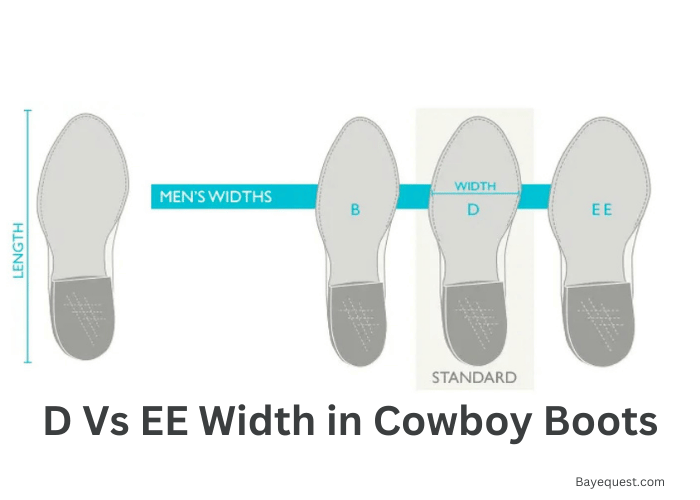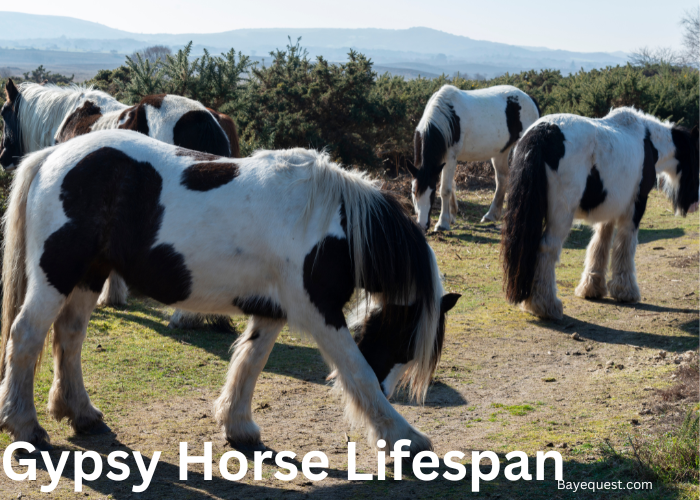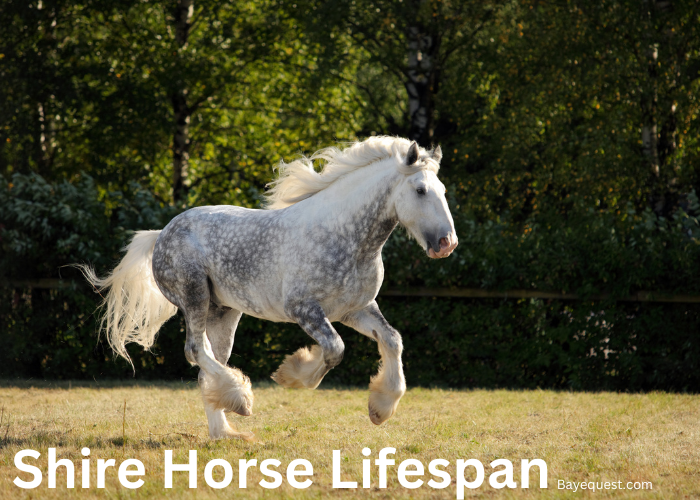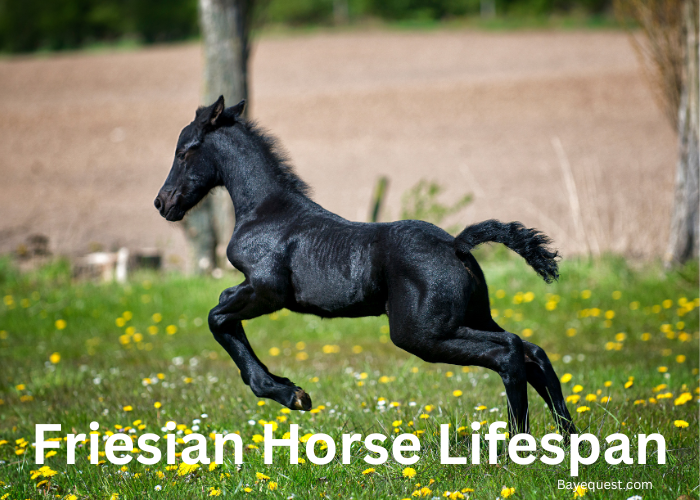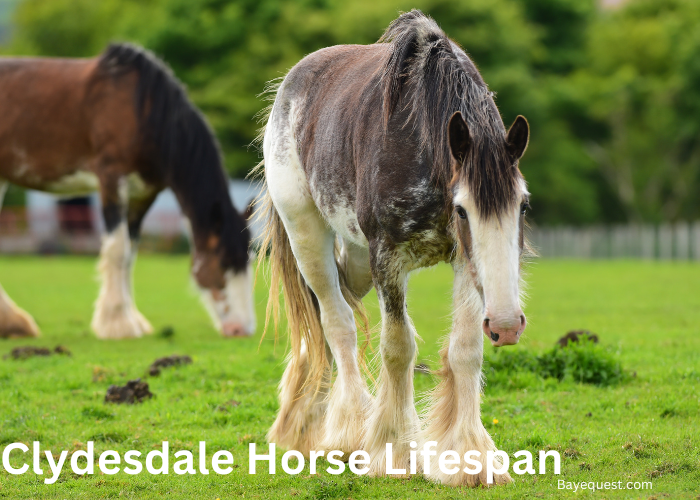Ever worn cowboy boots that felt like a tight squeeze? It’s not fun. Picking the right width makes all the difference.
Cowboy boots come in D and EE widths, and each offers a unique fit. Choosing the right one can save you from discomfort.
Today, we’ll break down these two widths. Whether your feet are narrow or wide, understanding the options will keep you comfortable.
Let’s explore this ultimate boot battle and help you find your perfect fit.
D Vs EE Width in Cowboy Boots: Key Takeaway
“D” width cowboy boots are designed for average feet, offering a snug and comfortable fit. “EE” width boots, on the other hand, provide an extra ½ inch of space, making them perfect for wider feet. To ensure the best fit, measure your feet and refer to our size guide.
Cowboy Boot Widths
Regarding cowboy boots, width is just as important as length. Width measurements help you find a boot that fits comfortably around the widest part of your foot.
Like regular shoes, cowboy boots come in different widths to accommodate different foot shapes.
Here are the most common width sizes you’ll see:
- A: Narrow. Suitable for feet that are slimmer than average.
- B: Medium. Often the standard width for women’s cowboy boots.
- C: Medium-wide. A bit wider than B for slightly broader feet.
- D: Standard width for men’s boots. Good for average foot width.
- E: Wide. For men with broader feet.
- EE: Extra wide. Offers more room for even wider feet.
Understanding these widths helps you choose the right fit. A well-fitted cowboy boot should be snug but not tight, with enough room to wiggle your toes.
Too tight, and you’ll be uncomfortable. Too loose, and your foot will slide around.
To find the right cowboy boots fit, check out our article.
The Basics of Cowboy Boot Sizing
Let’s break down cowboy boot sizing. It’s simpler than you think.
First, length matters. Just like regular shoes, cowboy boots come in various lengths. Do you know your shoe size?
Good, start there. But remember, different brands might fit differently, so always try them on if you can.
Next up, width is key. Cowboy boots come in different widths, like D and EE. D is standard for most men, while EE is wider.
If your feet are average, go for D. If they’re on the broad side, EE might be your best bet.
When you’re trying on boots, pay attention to the fit. The boot should feel snug around your instep, and your toes should have enough room to wiggle.
Walk around a bit. The heel should lift slightly but not slip off. Try a different width or size if it pinches or feels too tight.
Also, don’t forget about socks. Wear the type of socks you plan to wear with the boots when you try them on. Thick socks can make a difference in fit.
Lastly, remember that leather stretches. New boots might feel tight, but they’ll stretch and mold to your feet over time.
Still, they shouldn’t be painfully tight from the get-go.
That’s it. Remember these basics, and you’ll find cowboy boots that fit like a dream. Happy boot hunting
The D Size Boots
The D width is the standard width for men’s cowboy boots. Think of it as the middle ground. It’s designed to fit the average foot.
Not too narrow, not too wide, just right for most men. When you pick a D width, choose a balance that suits a regular foot size.
This width gives you a snug fit without squeezing your feet.
When to choose D width
You should choose a D width if:
1. You have an average foot width. D width is likely your best bet if your feet aren’t particularly narrow or wide. It’s made for the average guy’s foot.
2. Comfort is key. The D width is ideal if you want a boot that fits comfortably without feeling too tight or too loose. It offers a good balance of snugness and roominess.
3. Everyday use. If you plan to wear your cowboy boots daily for work or casual outings, D width will usually provide the comfort and support you need.
4. Trying on boots. When you try on boots, they should feel snug around the instep with room to wiggle your toes. If a D width fits this way, it’s the right choice.
Remember, a proper fit means no pinching or slipping, just a comfortable, secure feeling.
If your foot comfortably fits in a D width, stick with it. Your feet will thank you.
The EE Boots Width
Boot EE width is wider than the standard D width. It’s designed for people with broader feet.
This extra width gives your feet more room to spread out, reducing the chance of pinching or squeezing.
If you often find regular-width shoes too tight, the EE width might be the perfect solution.
When to choose EE on boots
You should choose boot size EE width if:
1. You have wide feet. If your feet are broader than average, EE width will give you the extra space for comfort.
2. Comfort over snugness. If regular-width boots feel too tight or cause discomfort, the EE width provides a roomier fit. This can prevent issues like blisters or pressure points.
3. Everyday use with wider feet. If you plan to wear your cowboy boots daily and have wide feet, EE width ensures you stay comfortable all day long.
4. Trying on boots. When you try on boots, they should feel comfortable around the instep and toes without any tight spots. If a D width feels too snug, the EE width will likely offer the right fit.
Remember, choosing the right width is all about comfort. If your foot feels better in an EE width, it’s your best choice.
D Vs EE Width in Cowboy Boots: Differences and Similarities
Now, let’s look at some differences and similarities between boot size EE and D:
1. Boot size EE vs D: Width measurement
D Width: This is the standard width for men’s cowboy boots. It’s designed for average foot widths and provides a snug but comfortable fit for most people.
EE Width: This is a wider width option. It’s for people with broader feet, offering more room and reducing tightness.
2. Boot size D vs Ee: Fit and comfort
D Width: It fits snugly around the instep and provides a secure fit without being too tight. It is ideal for those with average-width feet.
EE Width: This width offers a roomier fit, especially around the forefoot. It helps prevent pinching and squeezing, making it suitable for people with wide feet.
3. Cowboy boots Ee vs D: Purpose
D Width: Great for everyday use if you have average feet. It provides a balance of comfort and snugness, perfect for daily activities.
EE Width: Ideal for those who need extra room. If you have wide feet or often experience tightness in standard-width boots, EE width is the way to go.
4. D vs Ee boot sizing width: Design
Both D and EE widths are designed to provide comfort and support. They come in various styles and materials, ensuring you don’t compromise on looks.
5. D vs Ee boot shoe width: Quality
Both widths are available in high-quality cowboy boots. You can find durable, stylish options whether you need D or EE width.
How to Choose the Right Cowboy Boot Width
Choosing the right boot width doesn’t have to be tricky. Here’s how to do it:
First, know your foot size. Measure your feet at home. Stand on paper, trace your foot, and measure the widest part. Compare that measurement to a sizing chart to see if you’re average (D) or wide (EE).
Next, try on the boots. If you can, go to a store. Put on the boots and walk around. They should feel snug but not tight. Your toes should wiggle a bit. If the boots pinch or squeeze, try a wider width. If they feel loose, go for a narrower size.
Remember, comfort is key. Don’t assume the boots will stretch a lot over time. They’ll give a little, but they should feel comfortable from the start. Pay attention to how they fit around the instep and toes.
Also, consider your everyday use. If you wear boots daily with wide feet, EE width will be more comfortable. If you have average feet, D width should work just fine.
Finally, don’t rush. Take your time to find the right fit. It’s worth it to have boots that feel good all day long.
With these tips, you’ll find the perfect cowboy boots that fit like a glove. Happy boot shopping.
Male Sizing Chart
Need the perfect cowboy boot fit? Check out our male sizing chart to find your ideal size and width.
| US Size | Female Sizing Chart | Female Sizing Chart | Female Sizing Chart |
| 7.0 | 9.625 | 3.8 | 4.0 |
| 7.5 | 9.75 | 3.85 | 4.05 |
| 8.0 | 9.9375 | 3.9 | 4.1 |
| 8.5 | 10.125 | 3.95 | 4.15 |
| 9.0 | 10.25 | 4.0 | 4.2 |
| 9.5 | 10.4375 | 4.05 | 4.25 |
| 10.0 | 10.5625 | 4.1 | 4.3 |
| 10.5 | 10.75 | 4.15 | 4.35 |
| 11.0 | 10.9375 | 4.2 | 4.4 |
Female Sizing Chart
Looking for the perfect fit? Our female sizing chart will help you find your boots’ ideal size and width.
| US Size | Foot Length (Inches) | B width (Inches) | C Width (Inches) |
| 5.0 | 8.5 | 3.2 | 3.4 |
| 5.5 | 8.75 | 3.25 | 3.45 |
| 6.0 | 8.875 | 3.3 | 3.5 |
| 6.5 | 9.0625 | 3.35 | 3.55 |
| 7.0 | 9.25 | 3.4 | 3.6 |
| 7.5 | 9.375 | 3.45 | 3.65 |
| 8.0 | 9.5 | 3.5 | 3.7 |
| 8.5 | 9.6875 | 3.55 | 3.75 |
| 9.0 | 9.875 | 3.6 | 3.8 |
How to Measure Your Foot to Find the Right Sizing
Measuring your foot at home is easy. Here’s how to do it:
First, grab a piece of paper, a pen, and a ruler. You’ll also need a flat surface, like a floor.
1. Place the paper on the floor. Make sure it doesn’t move around.
2. Stand on the paper. Put your foot flat, with your weight evenly distributed.
3. Trace your foot. Hold the pen straight up and down, and trace around your foot. Stay as close to your foot as possible without angling the pen.
4. Measure the length. Use the ruler to measure from the heel to the longest toe. Write down this measurement.
5. Measure the width. Find the widest part of your foot and measure across. Write down this measurement too.
6. Now, compare your measurements to a sizing chart. Match the length to the US size. Check the width to see if you need a standard or wide boot.
Remember, it’s best to measure your feet in the evening. Feet swell throughout the day, so this gives you the most accurate size.
The Consequences of Neglecting Size Guides & Boot Width Charts
Ignoring size guides and boot width charts can lead to a world of hurt. Literally.
First off, blisters galore. Boots that are too tight rub your feet the wrong way. This means blisters, sore spots, and a lot of discomfort. Not fun.
Then there’s foot pain. Boots that don’t fit right mess with your feet. Too tight, and your feet feel squished. Too loose, and they slide around. Either way, it hurts. And if your feet hurt, you’ll be miserable all day.
Posture problems come next. Badly fitting boots can throw off your balance. This affects your posture, leading to back pain and even knee issues. Your whole body feels the impact.
Don’t forget short boot life. Ill-fitting boots wear out faster. The leather stretches too much, the seams can tear, and the sole wears unevenly. You’ll find yourself shopping for new boots sooner than you’d like.
Lastly, there’s the waste of money. Buying boots that don’t fit means you might have to buy another pair. That’s cash down the drain, plus the hassle of returns and exchanges.
So, always check the size guides and boot width charts. Your feet, your body, and your wallet will thank you. Happy boot shopping, and stay comfy.
EE Vs D Width Boot: Which is Right for Me?
Choosing between EE and D-width boots can make a big difference in comfort. Here’s how to figure out which is right for you.
First, know your foot width. A D-width boot is likely your best bet if your feet are average width.
It’s the standard width for most men and should fit snugly without being too tight.
But if your feet are wider, consider the EE width. EE-width boots provide extra room, especially around the forefoot.
This prevents pinching and squeezing, giving your feet the space they need to feel comfortable.
When trying on boots, pay attention to the fit. A D-width boot should feel snug but not overly tight.
Your toes should have a little wiggle room, and the boot should fit comfortably around your instep.
If it feels too tight, try an EE width. The EE width will give you that extra space; if your feet are wider, you should feel more comfortable.
Also, think about how you’ll be using the boots. If you’re on your feet all day or do a lot of walking, comfort is key.
Wide feet in a D-width boot might hurt, so EE width is the better choice for all-day wear.
Lastly, don’t forget socks. If you wear thick socks, you might need the extra room of an EE width, even if your feet are average.
Always try on boots with the type of socks you plan to wear.
In short, D width is great for average feet, while EE width is perfect for wider feet. Try them on, walk around, and see which feels best.
Boots size D Vs Ee: Conclusion
Finding the right cowboy boot width is like finding the perfect dance partner. It needs to fit just right.
Too tight, and you’ll be hobbling. Too loose, and you’ll be slipping.
D width is your trusty standard. It’s great for average feet. But if your feet need more room to breathe, EE width is your friend.
Don’t skip the size guides. They’re there to help you. Measure your feet, try on different widths, and see what feels best. Your feet will thank you.
Happy boot hunting, and may your new boots fit like a dream.




